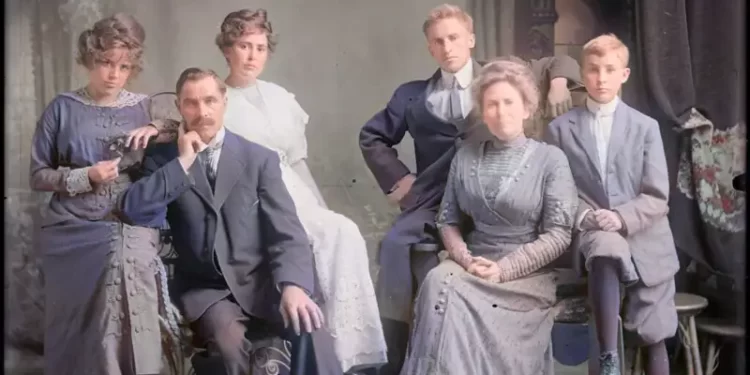In the sociology of family, the various family types sometimes overlap or become conflated due to the use of differing terminology for what are essentially the same thing. This is generally the case when it comes to stepfamilies, reconstituted families, and blended families. Here, I look at the definitions, types, myths, and issues of the three family types.
Definitions
If we look at a handful of definitions, we can see that each family type is defined in a very similar way.
For blended families:
Two divorced people who marry and each bring their children into a new family unit form a blended family
(Henslin, 2015: 385)
Blended families are formed when a biological parent cohabits with or marries a partner who is not the biological parent of his/her child
(Nixon & Hadfield, 2016: 1)
For stepfamilies:
Stepfamilies are formed when an adult with a child [or children] lives in a partnership with someone who is not the parent of their child [or children]
(Day, 2011: 2)
Stepfamilies are also formed by same-sex partners where one or both partners have children from prior relationships living in the household.
(Hutchison, 2017: 210)
For reconstituted families:
Reconstituted families are those in which a new member (or members) have been added to the family system of a biologically related natural family group. The new member or members have been chosen by at least one of the family members and are not by definition biologically related to them.
(Robinson, 1980: 45)
Reconstituted families consist of remarried men and women who have custody of their children from previous marriages. Structurally, these families are characterized by a relatively open system regarding inclusion of members
(Baptiste Jr, 1983: 6)
So, in general all three categories can be treated as being the same. Going forward, I use the three categories interchangeably depending on which works I am referring to but again all three categories are basically the same.
Types of Stepfamily, Blended Family, or Reconstituted Family
Howell et al. (1998: no pagination), writing from a counselling position, attempt to categorise blended families into different subtypes. The key to these subtypes appears to be in how the blended family focuses itself on the reformed relationships.
Integrated Families
Integrated families are couple-focused meaning that the blending of the family is happening around the main focal point of the new couple. Any other family and children are expected to adjust to this new relationship.
Invented Families
These blended families are focused more on building family and raising children. Rather than continuing the existing family structure, effort is made to forge a new family.
Imported Families
Imported Families are more focused on continuing the original family as opposed to implementing a new family structure. This means they are less adaptable to their new circumstances.
Myths of the Stepfamily, Blended Family, or Reconstituted Family
Like pretty much everything in sociology, there are pre-existing myths surrounding the realities of the reconstituted family which sociology attempts to deconstruct. It is perhaps important to cover these now rather than later as these myths can have a significant effect on the lived experiences of people in reconstituted families.
The Remarriage Belief Inventory (RMBI)
The RMBI was produced by Higginbotham & Adler-Baeder (2008). It is an empirical questionnaire validated and designed to measure the strength of beliefs about remarriages. In general, it gathers data around seven main mythical beliefs people have about stepfamilies:
- Adjustment should come quickly
- Stepfamilies are second-class
- Children should be the priority
- Past feelings should end
- Partner should be perfect
- Success is slim
- Finances should be pooled
As you can probably imagine, these are all beliefs that can easily create problems either for those who believe in them or those who are subjected to these beliefs by others. Beyond the RMBI, there are still more myths about the reconstituted family which are not considered by the test.
The Wicked Stepmother Myth
The wicked stepmother myth is the image of a female partner of a remarried father. Often depicted as cruel and abusive, the image of the wicked stepmother has been shown to be the majority theme in film plots between 1990 and 2003 (Leon & Angst, 2005). Beyond film they are also seen in fairy tales such as Hansel & Gretel. Together, these depictions seep into the common consciousness and can become embedded in professionalised systems such as medicine, education, or counselling (Coleman & Ganong, 1987). See also Whiting et al. (2007) and Planitz & Feeney (2009).
Recreated Nuclear Family Myth
This myth draws upon the idealised nuclear family to introduce toxic ideas around the ‘abnormality’ of the stepfamily. The core idea of ‘two parents, two children, first marriage’ gives the stepfamily an implied ‘deviance’. By holding on to the pretence that the new stepfamily is simply the nuclear family recreated, it brushes over potential difficulties that arise through the different structure of the stepfamily that should otherwise be addressed. Again, the ‘deviant’ aspect of the stepfamily becomes embedded in professional practices (Stanton, 1986: 202)
Instant Love Myth
The idea of ‘instant love’ refers to the belief that those entering into a reconstituted family arrangement do so without issue and on the basis of idealistic concepts of instantaneous love. It is a kind of abstraction where all the complex interplay that is required between each person to make a relationship functional is erased leaving only the perfect image of family. Further, it can manifest as the belief that stepparent and stepchild(ren) will form an instant bond. This latter example is particularly mythical as children generally approach new partners with hesitance thus believing in instantaneous love can come with a severe reality check.
A Stepparent Is Not a Parent
This is perhaps the most controversial. Visher & Visher’s (1978) classic paper on common problems for stepparents outlines some of the various myths about stepparents. However, I was drawn to a statement they made which specifically claims that a stepparent is not a parent. If we follow this logic then adoptive, foster, or other ‘parent’ figure must also not be a parent. This seems a relatively brutal approach to take especially if we are to consider what a child thinks. In a successful stepfamily, would a child see the stepparent as their actual parent? Further, the logic thus implies that there must be a consanguinity rule. Consanguine means related by blood therefore to be a parent must involve the blood relation, at least in Visher & Visher’s logic.
Issues in the Stepfamily, Blended Family, or Reconstituted Family
There are many issues when it comes to these family types and these issues can vary between ages, gender, and sexuality. Again, the myths we have just covered tend to arise within these issues.
Adjustment Issues
An adjustment issue is where one or more individuals have some kind of difficulty in adapting to a new situation. Children are often at the forefront of adjustment issues within the reconstituted family. In fact, it is such an important focus that there have been numerous models conceived through which adjustment issues are measured or studied. Saint-Jacques et al. (2017) outline many of these models which include those based on family structure, relationship quality, family resources, and life-course-based models.
Adjustment issues can arise for any individual in the reconstituted family and the main ones tend to be:
Role ambiguity and Confusion
New entrants to the reconstituted family may have undefined expectations about what their role will be within the family unit. For example, this can manifest arounds concepts such as the discipline of children, confusion around LGBT issues, boundaries, poor communication, and whether for example a stepparent is an authority figure.
Communication and Conflict Resolution
Children faced with new stepparents may have discomfort in expressing themselves to the new stepparent and, inversely, the stepparent may not know how to communicate with the child. This can translate into internalising and externalising behaviours for children (Jensen et al., 2018). Differing communication styles or differing beliefs around morals or norms, or even the myths discussed before, may also lead to conflict. Adapting to these issues can take a great effort by all parties especially since conflict resolution is a complex skill in itself.
Loyalty Issues
In the case of children, they are likely to have a greater loyalty to the biological parent than to the new stepparent. This can manifest as resentment, jealousy, or insecurity. Further, it can come in the form of a divided loyalty where they feel caught in the middle between both biological parents and the stepparents. This is particularly the case where there is parental conflict.
Living Arrangements
Again, particularly for children, living arrangements can be problematic. A child is often a member of two households rather than one and, as such, must juggle the roles that they play in each household. Similarly, they must also adapt to the various different roles of adults and stepsiblings in those multiple households. This is one reason why it can be particularly difficult for children when it comes to the reconstituted family. For the perspective of adolescents in stepfamilies see Lutz (1983).
LGBT
LGBT stepfamilies can face issues such as the lack of legal recognition or absence of rituals such as marriage which traditionally indicate the validating of the family unit. Bonds made within stepfamilies to stepchildren can be formed and then lost when separating as the stepparent generally lacks any legal recourse to child access arrangements normally conveyed to heterosexual, nuclear families. However, like heterosexual stepfamilies, there are similarities such as in who functions as the primary caregiver to children. The biological parent is usually the most involved in terms of the parenting role. LGBT stepfamilies can also be subject to the ‘triple stigmatisation’ which Berger (1998) argues consists of negative attitudes towards LGBT, the myths of stepfamilies, and a lack of support for parenthood within the LGBT community. See also Fredriksen-Goldsen & Erera (2004).
There are also many more issues which can be explored including issues around identity, self-perception, attitudinal issues, discrimination, class, or ex-spousal problems.
Think!
What is a parent?
How might different laws determine what a parent is?
Does a parent necessarily have to be a blood relation?
What about communally raised children?
To what extent are the problems experienced in a reconstituted family different from the nuclear family?
When thinking about adjustment models, is it the individual that has a problem adjusting or is the thing they are trying to adjust to actually the problem?
References
Baptiste Jr, D. A. (1983). Family therapy with reconstituted families: A crisis-induction approach. American Journal of Family Therapy, 11(4), 5–15. Taylor & Francis.
Berger, R. (1998). The experience and issues of gay stepfamilies. Journal of Divorce & Remarriage, 29(3-4), 93-102.
Coleman, M. & Ganong, L. (1987). The cultural stereotyping of stepfamilies. In K. Pasley & M. Ihinger-Tallman (Eds.), Stepparenting: Issues in theory, research, and practice (19-41). Westport, CT: Greenwood.
Day, A. (2011). ‘In the dark’: Voices of parents in marginalised stepfamilies: perceptions and experiences of their parenting support needs. Doctoral thesis, Northumbria University
Fredriksen-Goldsen, K. I. & Erera, P. I. (2004). Lesbian-headed stepfamilies. Journal of human behavior in the social environment, 8(2-3), 171–187. Taylor & Francis.
Henslin, J. (2015). Essentials of sociology: a down-to-earth approach. Boston: Pearson.
Higginbotham, B. J. & Adler-Baeder, F. (2008). Assessing beliefs about remarriages and stepfamilies: The remarriage belief inventory. Journal of Divorce & Remarriage, 48(3-4), 33–54. Taylor & Francis.
Howell, L. C., Weers, R., & Kleist, D. M. (1998). Counseling blended families. The Family Journal, 6(1), 42-45.
Hutchison, E. D. (2017). Essentials of human behavior: integrating person, environment, and the life course (2nd ed.). Los Angeles: Sage.
Jensen, T. M., Lippold, M. A., Mills-Koonce, R. & Fosco, G. M. (2018). Stepfamily relationship quality and children’s internalizing and externalizing problems. Family process, 57(2), 477–495. Wiley Online Library.
Leon, K. & Angst, E. (2005). Portrayals of stepfamilies in film: Using media images in remarriage education. Family Relations, 54(1), 3–23. Wiley Online Library.
Lutz, P. (1983). The stepfamily: An adolescent perspective. Family Relations, 367–375. JSTOR.
Nixon, E., & Hadfield, K. (2016). Blended Families. Encyclopedia of Family Studies, 1-5.
Planitz, J. M. & Feeney, J. A. (2009). Are stepsiblings bad, stepmothers wicked, and stepfathers evil? An assessment of Australian stepfamily stereotypes. Journal of Family Studies, 15(1), 82–97. Taylor & Francis.
Robinson, M. (1980). Step-families: a reconstituted family system. Journal of Family Therapy, 2(1), 45–69. Wiley Online Library.
Saint-Jacques, M.-C., Godbout, É., Drapeau, S., Kourgiantakis, T. and Parent, C. (2017). Researching Children’s Adjustment in Stepfamilies: How is it Studied? What Do we Learn? Child Indicators Research, [online] 11(6), pp.1831–1865.
Stanton, G. W. (1986). Preventive intervention with stepfamilies. Social work, 31(3), 201–206. Oxford University Press.
Visher, E. B., & Visher, J. S. (1978). Common problems of stepparents and their spouses. American Journal of Orthopsychiatry, 48(2), 252.
Whiting, J.B., Smith, D.R., Bamett, T. and Grafsky, E.L. (2007). Overcoming the Cinderella Myth. Journal of Divorce & Remarriage, 47(1-2), pp.95–109.












